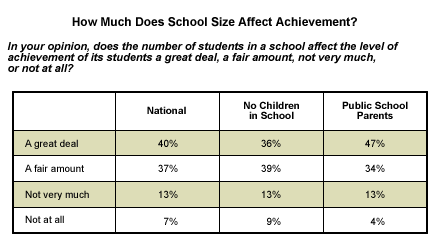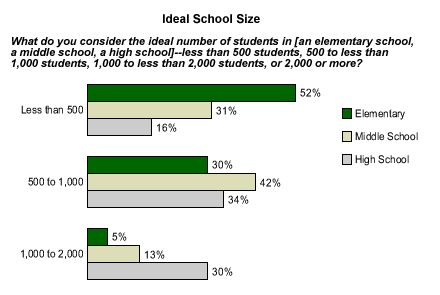The U.S. Department of Education recently published the final regulations of the 2001 No Child Left Behind Act. While the document has cleared up some educators' concerns, it has also introduced a few new ones. One of them centers on school capacity.
No Child Left Behind (NCLB) requires local schools to present parents with options, including the right to move children from "a school identified as in need of improvement" to a "better performing public school or public charter school," even if that school is in another district. This suggests that the better performing schools will be stuffed to capacity -- or perhaps beyond capacity -- rather quickly. While most Americans love the idea of choice in education, recent Gallup data show that many Americans already see swollen local schools as a problem.
Big Problem
Among the items in the 2002 Gallup/Phi Delta Kappa survey* on public education was the open-ended question, "What do you think are the biggest problems that the public schools in your community must deal with?" The most frequent answer, volunteered by 18% of respondents, was lack of funding (see "Americans List Biggest Challenges of U.S. Schools" in Related Items). But "overcrowded schools" was about even with "lack of discipline" for the second-most frequent response, spontaneously mentioned by 11% of Americans.
The Effect of Numbers
There is no doubt that Americans believe school size has a real effect on learning. When asked, "Does the number of students in a school affect the level of achievement of its students," 77% of Americans agreed that school size affects achievement "a great deal" (40%) or "a fair amount" (37%).

Clearly, overcrowding is a real concern. But how many students are too many? Gallup asked Americans what they feel are the ideal sizes of elementary, middle, and high schools. As it turns out, public opinion on the appropriate number of students for a school isn't far from the actual average number of students per school. If anything, the public's estimates of ideal size are higher than what is actually the case in the United States. Gallup calculated the following mean averages for the number of students that Americans think are optimal for schools: 520 for elementary schools, 711 for middle schools, and 1,033 for high schools. According to a 2001 National Center for Education Statistics report, the average elementary school has 443 students, middle schools average 605, and high schools average 751 students.

Key Points
The issue of optimal school size has been heavily researched. A hundred years ago, big schools were thought to be beneficial because of their bigger budgets and wider variety of academic offerings. Current research has found that this is still true -- sometimes. School size doesn't seem to negatively influence affluent districts. In fact, students in wealthy school districts tend to do a little better in bigger schools.
Current concerns about overcrowding have less to do with school size itself than with the need to provide adequate resources to schools of all sizes. The adverse effects of larger school sizes are more often felt in poor and rural schools than affluent ones, according to Matthew Project studies on school sizes. For example, consolidated schools in rural districts force long commutes to school and school activities -- so students miss many learning opportunities. Impoverished school districts, though they can claim heroic educators, aren't too attractive to most teachers and administrators, nor do they receive the equipment that wealthier schools get. If such resource inequities can be alleviated, the impact of school size on education quality may cease to be a concern.
*The findings from the 2002 Phi Delta Kappa/Gallup poll are based on telephone interviews with a randomly selected national sample of 1,000 adults, aged 18 and older, conducted June 5-26, 2002. For results based on this sample, one can say with 95% confidence that the maximum error attributable to sampling and other random effects is ±3%.